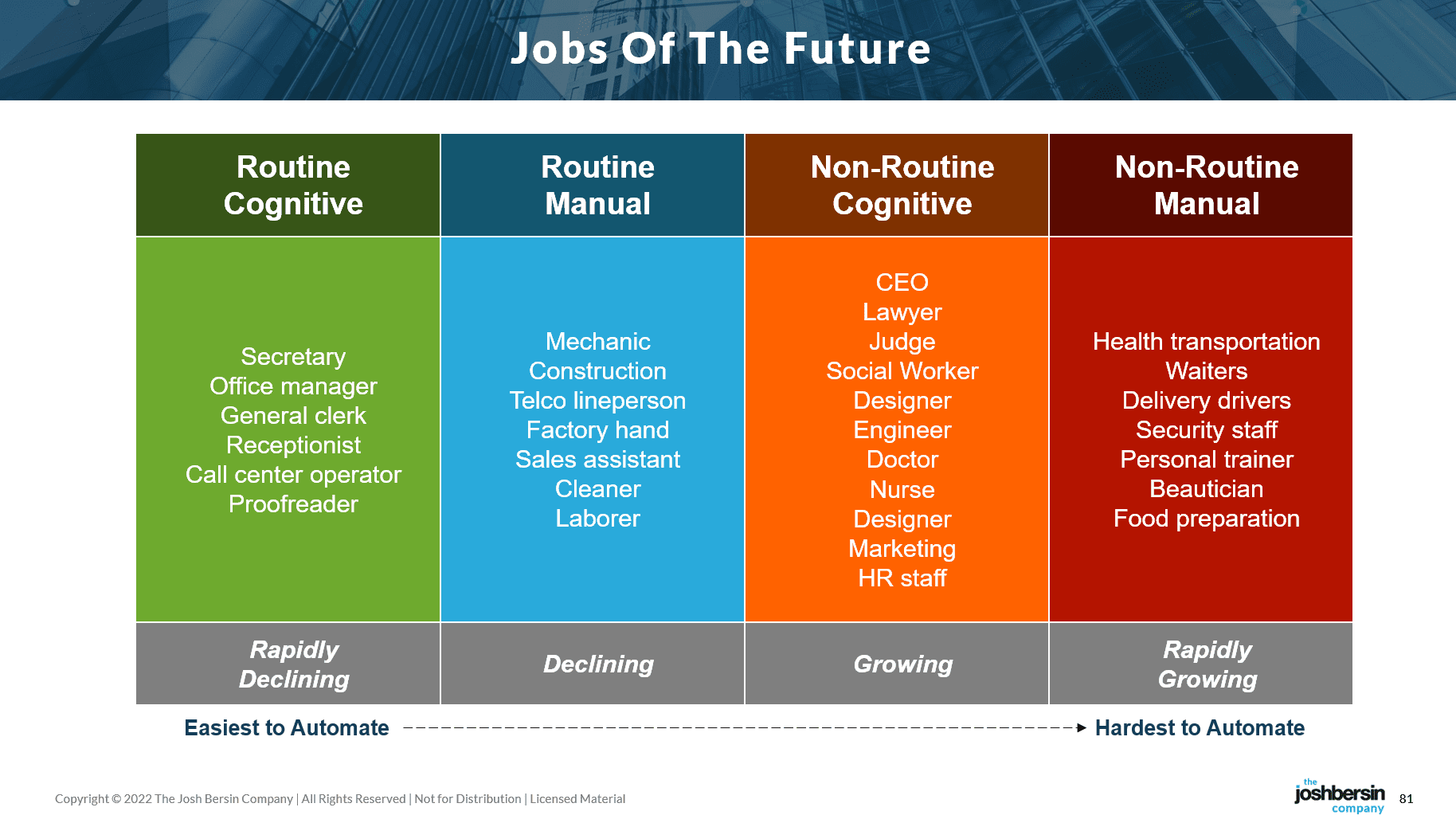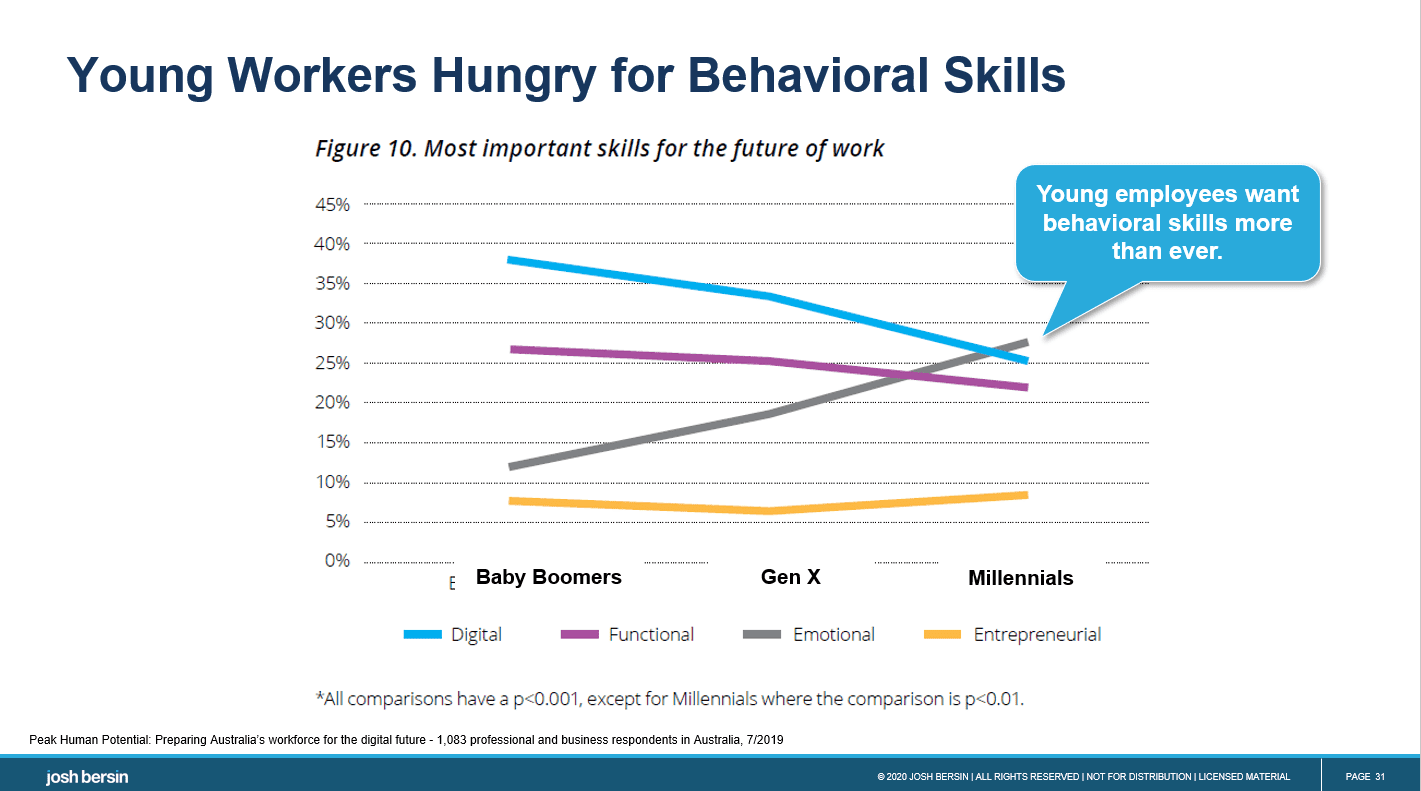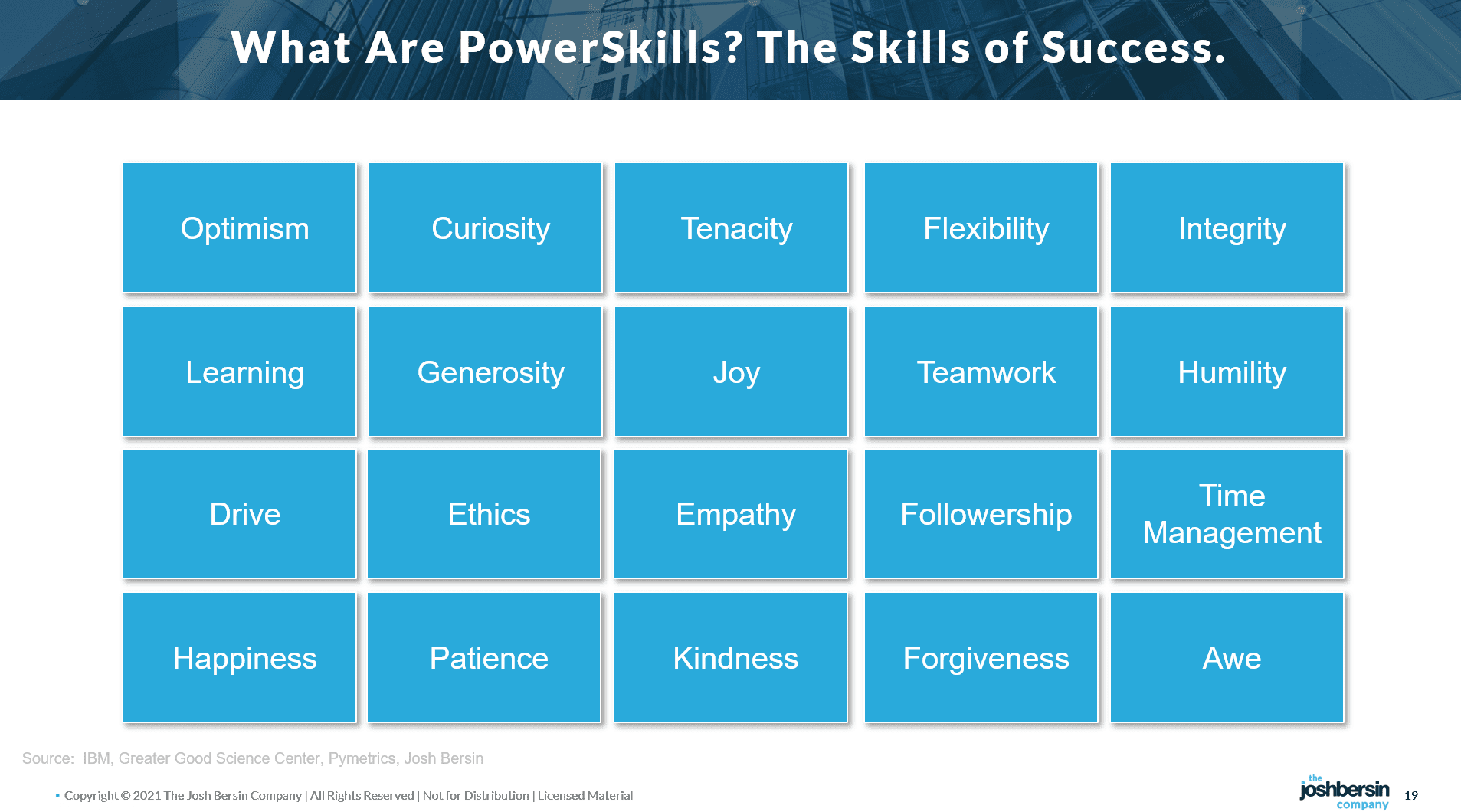We Are Becoming A PowerSkills Economy
Everyone keeps talking about the economy these days. Interest rates are rising, inflation feels out of control, and there’s a hint of recession in the air. Yet job growth remains strong and unemployment is low. What’s really going on?
After years of study and hundreds of conversations with business leaders, I’ve come to a big conclusion. Not only are we going through an economic cycle, but the global economy has changed. And this change, which I explain below, is creating high levels of employment, job growth, and economic opportunities despite the current business cycle.
Looking Back: The Theory That Automation Eliminates Jobs
Back in 2007, researchers at Oxford Economics, followed by the World Economic Forum, predicted that more than 45% of jobs would be “eliminated” due to automation. Economists and researchers talked about rapid workforce disruption, warning us that robots would be taking our jobs.
In reality, of course, quite the opposite has taken place. While routine work (defined below) has been reduced, non-routine work has exploded with growth. And this trend is creating jobs: better jobs, higher paying jobs, and jobs that require new skills.
Consider, for example, the automation of self-service retail, mobile phone orders, and in-store kiosks. These automation tools did away with call center jobs, retail order-taking, and routine jobs in sales and marketing. But the high volume of new transactions created created a multiplicity of jobs in service delivery, customer service and support, analytics, supply chain, and logistics. In fact this month purchasing managers institute announced that demand for “services” is at a 20 year high.
In other words, automation did not eliminate work at all – it created new jobs, better jobs, and an acceleration of our workforce into what we now call the “service economy.” We are essentially shifting to the right in this model.
 |
Fig 1: Typical academic categories of “routine” and “non-routine” work.
The National Bureau of Economic Research has studied this extensively. Among the many aspects of this shift, they conclude that this move from “routine” to “non-routine” is significant. Not only have “occupations” shifted, but the growth rate in non-routine jobs is almost 25 times higher than the growth rate in routine jobs. (Going back to 1976 until the 2014 period in this study.)
 |
What Are These Non-Routine Jobs?
These newer, higher paying jobs are often classified as services, but there are two definitions for this word.
First there is the Service Providing Industry, which the BLS defines as specific jobs in healthcare, financial services, education, trade, leisure, hospitality, and professional services. This industry group makes up more than 70% of US employment and its size and average wage has been growing at more than 5% per year (it’s share of jobs is increasing). Second, but even more important, is “service jobs,” which means jobs that require human skills in design, communication, care, or service. This latter definition now makes up more than 90% of the jobs in the United States.
I talk with HR executives all day, and we constantly hear talk about the need for design thinking, empathy, management, and leadership, as well as increased demand for jobs in clinical care, engineering, design, and logistics. Each of these jobs is “non-routine” in its own special way, and even the most sophisticated technology companies feel this pinch.
Consider that Facebook (Meta), Amazon, and Google now employ almost 40% of their workforce in contingent jobs to curate content, moderate social media, and decide or help decide how their systems will behave. The need to “train” and “moderate” and “improve” our intelligent machines is higher than ever, and these jobs are vital, important, and pay well.
A good example we can understand is sales automation. While companies like Salesforce, Hubspot, Seismic, Gong, and others are “automating the sales and marketing process,” the demand for sales people has gone through the roof. Today, according to Lightcast’s latest data, there are more than 12.5 million jobs open in the United States, and more than 580,000 of them are in sales. Clinical jobs like nursing, pharmacy technician, and other care jobs are similarly skyrocketing, with more than 650,000 jobs open today.
This demand is not due to economic growth: these are “higher level jobs” created through sales automation. Today, thanks to CRM tools, a sales person spends time pouring through Salesforce, looking for qualified leads, then crafting interesting emails or phone conversations to get people’s attention. Has “sales” been automated? Not really. It has been “augmented and improved” by automation, but it’s still a person-to-person job.
Look at roles like nursing (#1 job open in the US), management (600,000 jobs open), customer service (245,000 jobs open), and even food service and hospitality (more than 275,000 jobs open). None of these jobs has been “automated away,” rather they’ve grown in demand as more and more routine tasks become automated. (Read our new GWI research on healthcare for more.)
So Do We Need Technical Skills To Succeed?
And this leads me to my second point. Despite the large discussion about the need for scientists, engineers, and technical professionals (which are always in demand), the research also shows that technical careers, while critical and vital to our economy, are also turning into “services” jobs too.
I know this from my own experience. I was an engineer, sales engineer, and analyst for years. My technical skills started by genetics (my father was a physicist) and I always took to technical things easily. But as my career evolved, I kept find myself “passed over” for bigger jobs by people with more managerial expertise, ambition, or relationship skills. So over time, in my own case, I learned to be a leader, learned how to work well in teams, and learned a lot of things about group dynamics, teamwork, empathy, and development.
The same is true in the economy as a whole. Research done by IBM and also by Bloomberg found that CEOs don’t only want technical skills, they are desperately looking for people who are creative, can solve complex problems, manage large teams of people, and deal with strategy, time management, and organizational growth. Technical salaries do go up with specialization, but almost every study of pay shows that “managerial roles” pay 50-100% more, even in highly technical domains.
 |
Fig 2: Fed Reserve research shows that jobs with “high social” and “high analytic” (blue) far outperform “technical only” jobs (green) over time.
Yesterday I spent a day with one of the world’s largest technology companies. Guess what their biggest challenge is? It’s not technical expertise or engineering hiring: it’s management, leadership, and culture. And this makes perfect sense. Yes, it’s hard to hire and manage the world’s best scientists and engineers, but try being the boss, leader, or manager of these brilliant people. That is a really tough job.
And this leads me to my headline. We are becoming a PowerSkills economy: driven not only by technical skills, but even more by empathy, design, communications, and management. What do you think the #1 skill in demand on LinkedIn? It’s not software or data analytics: it’s “communications.” And this makes sense. If you can’t listen and communicate your thoughts well, there aren’t many jobs you can really do.
By the way, younger workers know this. Since most young professionals come into the workforce with many technical skills, they want behavioral skills more than ever (the right side of this chart.)
 |
Fig 3: Australian research shows that younger workers believe behavioral skills are key to their success.
What Are PowerSkills And How Do We Develop Them?
So what are these magical PowerSkills? Here is our best set, built around hundreds of conversations with psychologists and business leaders around the world.
 |
As Brene Brown discusses in her writings, our economy has evolved from muscles to brains to heart.
- In the 1800s and early 1900s we were in the Industrial Age: the era of muscle. We needed workers with strength, dexterity, and physical stamina.
- In the 1960s through 2000s we entered the Information Age: the era of brains. We looked for workers with analytics skills, raw intelligence, and mental processing power.
- Today, thanks to automation, we need workers with empathy: the era of heart. We face issues with focus, productivity, and performance. We need workers with wisdom, empathy, and heart.
We’ve studied this extensively, and our research on Human-Centered Leadership explains this in detail. (Corporate membership or Josh Bersin Academy membership required.)
What This Means For Economics And Business
So what does this all mean? To me there are three lessons here.
First, we have to focus our energies beyond “technical skills” in our education, training, development, and recruitment. Educational institutions, policy makers, and companies have to take PowerSkills (often called SoftSkills) seriously, because they are the “hard skills” of the future. You should define these skills, talk about them, reward them, and continuously develop them.
Second, economic growth is now dependent on our ability to understand this shift. An interesting study by the IZA Institute of Economics looked at these trends and found that the slowest growing economies actually had a much larger percentage of jobs with “routine intensive roles.” In other words, if you don’t design and engineer jobs to move to the right above, your company and your country will suffer economic loss.
Third, low unemployment may be here to stay. Traditional economics says that businesses lay off workers when the economy slows. But that formula is starting to change. Why? The economy is constantly “reinventing work,” creating new jobs as other become more obsolete. The fertility and marriage rates are low, so fewer workers are being born – thus the “demographic drought” is creating a limited supply. So productivity will go up (it has been during the recession) and jobs will continue to be hard to fill.
Our new Global Workforce Intelligence research on healthcare explains this in detail. Healthcare providers that thrive in this difficult time are those who can re-engineer work, automate the “routine tasks” in their facilities, and spend lots of time training and developing people to bring PowerSkills to work.
This is the Future of Work as I see it: not a world where technology replaces people, but rather one where jobs continuously get better. Leveraging these trends are key to growth in the future.
Additional Information
Human Centered Leadership: A Josh Bersin Academy Certificate Program
The Healthcare Industry Has A Talent Crisis: We Found The Cure.


